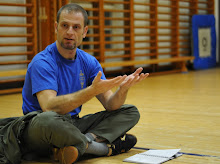 A few months after I wrote this article, I was reading a textbook on the "constraints led approach" to motor control and learning. In that book, a chapter was included on the ecological psychology perspective on skills acquisition. In a few words, ecological psychology, also known as "direct perception", is a school of psychology based on the work of James Gibson [1] who argued that animals and humans stand in a 'systems' relation to the environment, such that, to fully explain some behaviour, it was necessary to study the environment in which this behaviour took place. The aphorism "It's not what is inside the head that is important, it's what the head is inside of", seems to capture that point [2]. Now, the reason ecological psychology is appealing to those involved with the study of motor learning and control is because it seems to provide answers on what is happening when acquisition of motor skills (such as a throwing technique, a punch, etc.) occurs without awareness of what is happening, i.e. when people cannot exactly explain how they move when they perform a specific skill.
A few months after I wrote this article, I was reading a textbook on the "constraints led approach" to motor control and learning. In that book, a chapter was included on the ecological psychology perspective on skills acquisition. In a few words, ecological psychology, also known as "direct perception", is a school of psychology based on the work of James Gibson [1] who argued that animals and humans stand in a 'systems' relation to the environment, such that, to fully explain some behaviour, it was necessary to study the environment in which this behaviour took place. The aphorism "It's not what is inside the head that is important, it's what the head is inside of", seems to capture that point [2]. Now, the reason ecological psychology is appealing to those involved with the study of motor learning and control is because it seems to provide answers on what is happening when acquisition of motor skills (such as a throwing technique, a punch, etc.) occurs without awareness of what is happening, i.e. when people cannot exactly explain how they move when they perform a specific skill.So then, what does ecological psychology and direct perception have to do with movement, the third pillar of Systema??? Well, a central idea in Gibson's work is that movement generates information, which leads to further movements and so on, i.e. indicates a cyclical relationship between perception and movement. "We must perceive in order to move", wrote Gibson, "but we must also move in order to perceive"[3].
In one of our recent training sessions at the Göteborgs Systema-RMA Klubb we were practicing a drill were one person lies down on the floor (prone or supine position doesn't matter), three or more training partners lie on top of him, acting as dead weight and then he must find a way to "escape" from this positon. My interpretation of this drill is that, once under a pile of bodies, one must first and foremost find a way to breathe, locate a part of the torso which is not compressed where the minimum of movement required by breath can occur (being able to breathe delays the onset of panic and trust me, there's nothing that spells panic more than 300 kilograms placed on your chest). Once this fundamental movement of breath can be performed, it provides information about which direction one should move towards, in order to escape from underneath - where there's space to breathe, there is space to escape!!!
Let's see another example of movement providing information that lead to further movement: have you ever seen a MMA fight where the competitors spend way too much time in a standing clinch position, without either of them doing anything decisive, peppering each other with annoying but not effective punches? In my oppinion, when some fighters get in the clinch they are mostly worried about being taken down, so they just brace defensively, remain immobile, and waste precious energy without implementing (actually, without even trying to implement) their strategic plan. What experienced fighters do when they get in the clinch, is continously move: they use the box stepping pattern and try to break their opponents posture, so they can initiate a throwing technique, disengage, or just create space in order to generate some serious striking power (as opposed to pitty-patting their opponent).
There is an old-scool boxing saying, according to which "when you do not know what to do in the ring, just use your jab". I guess that a more inclusive version of this might be "when you don't know what to do, just move" - because movement not only equals ability, it also provides the information on how to use your abilities.
References:
[1] http://en.wikipedia.org/wiki/J._J._Gibson
[2] http://en.wikipedia.org/wiki/Ecological_psychology
[3] Davids, K., Button, C., Bennett, S. Dynamics of Skill Acquisition: A Constraints-Led Approach. Human Kinetics 2008, p. 65
If you want to knnow more about ecological psychology and direct perception, you can find a very good texbook by Claire Michaels and Claudia Carello, in pdf format here.







No comments:
Post a Comment